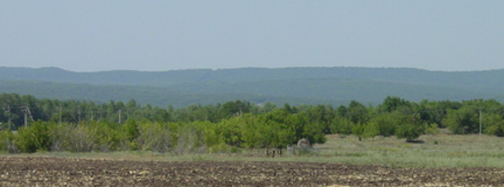Schönchen (Paninskaya)
Schönchen (Paninskaya), Russia was established in 1767 and located 10 miles up the Little Karaman River just north of the newly established village of Ober-Monjou. By 1770 they determined the soil was not suitable for farming and relocated the village 40 miles northeast of Katharinenstadt (Marx), between the two Catholic villages of Zug (Gattung) to the south, and Solothorn (Wittman) to the north. This location was on the Wiesenseite of the Volga River near the Karshinaya Brook.
The livelihood of most villagers consisted of farming. They kept with the tradition of their homelands by traveling to their farmlands during the day and returning to their homes in the village at the end of the day. They grew rye, wheat, barley, oats, millet, potatoes and tobacco, with the village homes keeping vegetable gardens to supply food for the family table. They also raised cows, sheep, swine and chickens and kept a stable of horses.
In the late 1870's, as part of a larger Volga German migration to destinations in the United States and South America, several families from Schönchen migrated to the U.S. in search of freedom from an increasingly oppressive government. For those who remained, the future was one they could not have imagined. During World Word II, with Russia at war with Germany, the Volga Germans were considered suspect of loyalty to the German government. On August 28, 1941, Stalin ordered a Decree of Banishment of those Volga Germans to areas of Sibera and Khazakstahn, leaving this once prosperous farming area of Russia almost devoid of those who made it so.
On a trip to the Volga in August 2002, the evidence of that time in history perhaps would not be much noticed if one didn't know that churches, cemeteries, homes and other signs of a thriving community once existed. Although the neighboring villages of Zug (Gattung) and Solothurn (Wittman) have survived, Schönchen did not. All that remains are two tombstones in a small area enclosed in chains. In Zug and Solothurn there were no Volga Germans who lived there, but the villagers did remember them with their "neat homes and gardens". We were told that up to 30 years ago, Schönchen still had some residents, but they were then moved to Zug.

Present day site of Schönchen, Russia. The two remaining grave markers appear near the center of the photo. Photo taken 2002.
As village coordinators for AHSGR, our goal is to keep the memory of those Schönchen residents alive through their descendants. We would greatly appreciate any assistance from those families who have done research on their families from this village. Likewise, we are available to assist you with your questions and guide you with your research.
Spelling Variants
During our research we've encountered a variety of spelling variations for Schönchen's Russian village name. Have you seen another spelling to add to our list?
- Panino
- Paninska
- Paninskaya
- Paninskoje
- Panninskoy
- Panniske
- Panniskei
- Pannintzka
- Panicerakaj
- Raninskoe
In Russian Cyrillic, Schönchen is Шенхен; Paninskaya is Панинская.